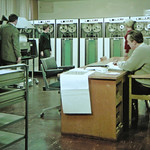 The National Museum of Computing in the United Kingdom has just gotten its hands on the last operating ICT 1301 mainframe computer (not the one pictured), which endured decades of being treated as scrap before its last private owner and a group of enthusiasts restored it to working condition. David Szondy has more on the story for GizMag.
The National Museum of Computing in the United Kingdom has just gotten its hands on the last operating ICT 1301 mainframe computer (not the one pictured), which endured decades of being treated as scrap before its last private owner and a group of enthusiasts restored it to working condition. David Szondy has more on the story for GizMag.
Massive early mainframe computers
It took three moving vans to deliver the ICT 1301 computer, lovingly referred to as “Flossie”, to TNMOC’s storage facility in Milton Keynes, UK. This isn’t surprising, as Flossie weighed more than five tons and had a footprint of about six metres by seven metres. This is typical of early mainframe computers. Flossie, as a matter of fact, was even marketed as smaller than its gigantic contemporaries.
For its massive size, Flossie has less computing power than your wristwatch. Manufactured by International Computers and Tabulators (ICT), Flossie had a clock speed of 1 Mhz. Its main memory had 12 kb, while eight magnetic storage drums had 72 kb for a total of 576 kb. Punch cards and non-industry standard magnetic tape were used to program it.
To be displayed with other historic functional computers
Now that Flossie is in the custody of TNMOC, plans are already being drawn up to bring the giant computer back to life, and put it on display in the near future. With TNMOC’s
Exemplary track record in of restoring old computers and maintaining their full functionality, it is hoped that Flossie will eventually be displayed alongside other historic functional computers like the Colossus, the world’s first electronic computer, and the WITCH, the world’s oldest working digital computer.
To read the full article, click here.
